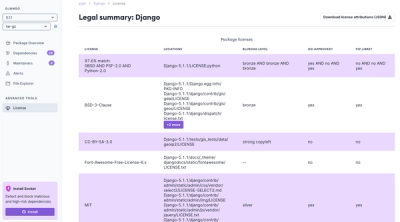
Product
Introducing License Enforcement in Socket
Ensure open-source compliance with Socket’s License Enforcement Beta. Set up your License Policy and secure your software!
com.worldline.playground:payment-sdk-common
Advanced tools
This library simplifies the use of SIPS 2.0, the Worldline e-payments API
This package provides a JAVA implementation for SIPS, the Worldline e-payments gateway.
:warning: This library was written for SIPS 2.0 and is not compatible with SIPS 1.0!
dependencies {
implementation 'com.worldline.sips:payment-sdk:1.1.1'
}
<dependency>
<groupId>com.worldline.sips</groupId>
<artifactId>payment-sdk</artifactId>
<version>1.1.1</version>
</dependency>
:bulb: Currently this library only supports SIPS in pay page mode.
First, create a client for the desired environment using your merchant ID, key version & secret key:
PaypageClient paypageClient = new PaypageClient(
Environment.SIMU,
"002001000000002",
1, // This shouldn't be hardcoded here...
"002001000000002_KEY1"); // ...and neither should this.
Then set up a request to initalize a session on the SIPS server:
PaymentRequest paymentRequest = new PaymentRequest();
paymentRequest.setAmount(2);
paymentRequest.setCurrencyCode(Currency.EUR);
paymentRequest.setOrderChannel(OrderChannel.INTERNET);
Add unique reference for the transaction:
paymentRequest.setTransactionReference("My awesome transaction reference");
And initialize your session on the server:
InitalizationResponse initializationResponse = paypageClient.initialize(paymentRequest);
The initializationResponse you'll receive from the server contains all information needed to continue
handling your transaction. If you're initialization was successful, your response will contain a
RedirectionStatusCode.TRANSACTION_INITIALIZED.
In case your initialization was successful, you have to use the redirectionUrl received to perform a POST request
with both the redirectionData and seal as parameters. Since this should redirect the customer the SIPS
payment page, the cleanest example is a simple HTML form:
<form method="post" action="redirectionUrl">
<input name="redirectionData" type="hidden" value="..." />
<input name="seal" type="hidden" value="..." />
<input type="submit" value="Proceed to checkout"/>
</form>
When your customer is done, he will be able to return to your application. This is done
via a form, making a POST request to the normalReturnUrl provided during the initialization of your payment.
This POST request contains details on the payment. You can simply decode these responses, providing a Map<String, String>
of the parameters included in the received request to your PaypageClient:
PaypageResponse paypageResponse = paypageClient.decodeResponse(mappedRequestParameters);
:warning: Since the customer is not always redirecting back (e.g. he closes the confirmation page), it's a a good practice to include an
automaticResponseUrl. SIPS will always POST details on the transaction on this URL, even if a customer doesn't redirect back to your application.
FAQs
This library simplifies the use of SIPS 2.0, the Worldline e-payments API
We found that com.worldline.playground:payment-sdk-common demonstrated a not healthy version release cadence and project activity because the last version was released a year ago. It has 0 open source maintainers collaborating on the project.
Did you know?

Socket for GitHub automatically highlights issues in each pull request and monitors the health of all your open source dependencies. Discover the contents of your packages and block harmful activity before you install or update your dependencies.

Product
Ensure open-source compliance with Socket’s License Enforcement Beta. Set up your License Policy and secure your software!

Product
We're launching a new set of license analysis and compliance features for analyzing, managing, and complying with licenses across a range of supported languages and ecosystems.

Product
We're excited to introduce Socket Optimize, a powerful CLI command to secure open source dependencies with tested, optimized package overrides.